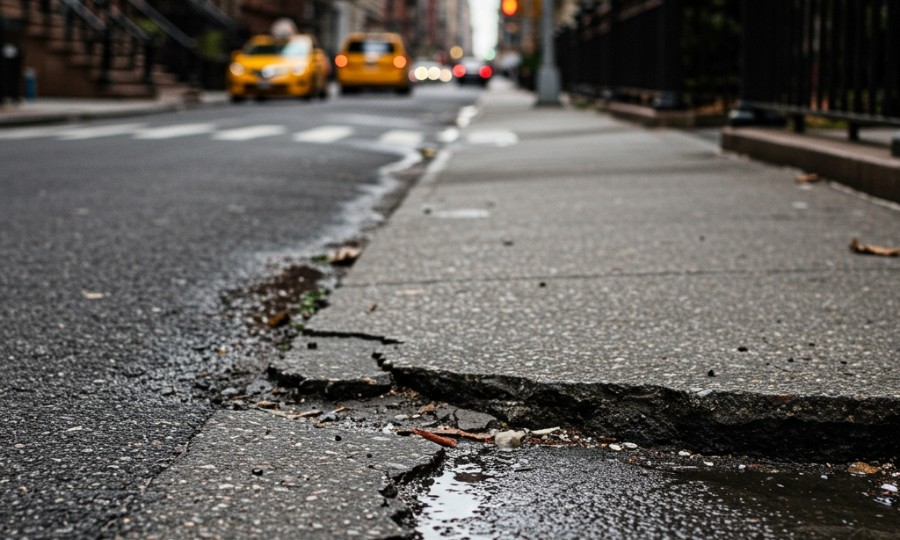
Navigating Sidewalk Accidents in NYC: Your Guide to Liability and Rights
New York City’s sidewalks are the arteries of our vibrant metropolis. Millions of people walk them daily. However, these vital pathways can sometimes hide dangers, leading to unexpected slip and fall accidents. A seemingly minor crack or uneven slab can cause serious injuries. If you’ve been hurt on a defective sidewalk, you might wonder who is responsible. This question is often complex in NYC, as specific laws govern sidewalk maintenance and liability. Consequently, understanding these rules is crucial for anyone seeking justice after an accident.
Understanding the Shift: NYC Administrative Code § 7-210
For many years, the City of New York held primary responsibility for maintaining its sidewalks. This meant suing the city was often the first step in a sidewalk accident case. However, everything changed on September 14, 2003. On that date, NYC Administrative Code § 7-210 took effect. This pivotal law dramatically shifted the burden of sidewalk maintenance and liability. Specifically, it transferred this responsibility from the City of New York to the owners of properties abutting sidewalks. Therefore, most property owners in New York City are now legally obligated to maintain their sidewalks in a reasonably safe condition.
This law aims to ensure safer pedestrian environments. Property owners must keep their sidewalks free from defects, including cracks, unevenness, holes, and other dangerous conditions. Failure to do so can lead to liability if someone is injured due to a hazardous sidewalk. However, there are important exceptions to this rule. For instance, owners of one, two, or three-family owner-occupied residential properties are generally exempt from this liability shift. Furthermore, the City retains responsibility for certain sidewalk conditions, such as those caused by city tree roots or utility covers. Knowing these distinctions is vital for your case.
The “Trivial Defect” Doctrine: Not Every Imperfection Leads to Liability
Even if a sidewalk has a defect, it doesn’t automatically guarantee a successful personal injury claim. New York courts recognize what’s known as the “trivial defect” doctrine. This doctrine acknowledges that not every minor imperfection or unevenness on a sidewalk constitutes a dangerous condition for which a property owner can be held liable. Essentially, some defects are considered too small or insignificant to be legally actionable. This principle prevents endless litigation over every tiny bump or crack.
Consequently, determining whether a defect is “trivial” is often a central point of contention in sidewalk accident cases. Courts consider various factors when making this determination. These factors include the size, shape, and appearance of the defect. Additionally, they assess whether the defect has characteristics of a “trap” or “snare.” The visibility of the defect is also important. Was it openly and obviously discoverable? Lighting conditions at the time of the accident play a role. Moreover, the presence or absence of warning signs can be relevant. The location of the defect on the sidewalk, like proximity to a crosswalk, can also influence the court’s decision. Finally, evidence of prior accidents at the same location might indicate a non-trivial hazard. Therefore, a thorough investigation of all these elements is essential.
For example, a mere difference in elevation of less than an inch might be considered trivial. However, if that same small difference creates an abrupt edge or is obscured, it might not be trivial. The courts carefully examine the specific circumstances of each case. They aim to distinguish between minor, unavoidable irregularities and genuinely hazardous conditions. Therefore, don’t assume your injury is without recourse just because the defect seemed small. A seasoned attorney can help evaluate your specific situation and determine if the defect truly was “trivial” under the law.
The Importance of “Notice” in Sidewalk Accident Cases
Another critical element in many personal injury cases, especially those involving property defects, is “notice.” Generally, to hold a property owner or municipality liable for a dangerous condition, they must have had some form of “notice” of the defect. This means they knew or should have known about the hazardous condition but failed to fix it. Notice can be actual or constructive.
Actual notice occurs when the property owner was directly informed about the defect. Perhaps someone complained, or they personally observed it. Conversely, constructive notice means the defect existed for a long enough period that the owner should have discovered and remedied it through reasonable inspection. For example, a large crack that has been present for months would likely constitute constructive notice. On the other hand, a fresh pothole that appeared overnight might not.
In New York City, a unique system exists for documenting sidewalk defects: the Big Apple Pothole and Sidewalk Protection Committee. This committee maintains maps detailing reported defects throughout the city. If a defect you tripped on was documented on one of these maps prior to your accident, it can serve as powerful evidence of prior notice. This resource can be invaluable for building a strong case. Consequently, our firm often consults these maps during our investigations.
What to Do After a Sidewalk Slip and Fall Accident
An unexpected fall on an NYC sidewalk can be disorienting and painful. However, your actions immediately following the accident are crucial for protecting your health and any potential legal claim. First and foremost, seek medical attention immediately. Your health is paramount. Even if you feel fine initially, some injuries, like concussions or soft tissue damage, may not manifest symptoms until later. A medical record also provides vital documentation of your injuries, linking them directly to the accident.
If you are able and it is safe to do so, try to document the scene. Use your smartphone to take clear photos and videos of the defect that caused your fall. Capture various angles and distances. Include landmarks to show the exact location. Furthermore, if there are any witnesses, kindly ask for their contact information. Their testimony can be invaluable later on. However, do not give statements to the property owner, their insurance company, or anyone else without first speaking to a lawyer. Anything you say could potentially be used against you.
Finally, contact an experienced New York City personal injury lawyer as soon as possible. Navigating sidewalk liability laws, including Administrative Code § 7-210 and the trivial defect doctrine, requires specific legal knowledge. A lawyer can investigate the accident, gather evidence, determine who is liable, and ensure your rights are protected. They can handle communications with insurance companies and negotiate on your behalf. This allows you to focus on your recovery without added stress.
How RMFW Law Can Help You
At RMFW Law, we understand the challenges and anxieties that follow a personal injury. We have dedicated our practice to helping injured New Yorkers navigate complex legal landscapes with compassion and expertise. Our team of trusted NYC personal injury lawyers has extensive experience with sidewalk defect cases. We meticulously investigate every detail, from examining the defect’s characteristics to researching property ownership and checking Big Apple maps for prior notice. We work tirelessly to build a strong case on your behalf.
We know that suffering an injury due to someone else’s negligence is unfair. You deserve clear answers and confident next steps. We will explain your legal options in plain English, ensuring you understand every stage of the process. Our goal is to secure the maximum compensation you deserve for medical bills, lost wages, pain and suffering, and other damages. We handle the legal complexities so you can focus on healing. Your journey to recovery is our priority.
Taking Your Confident Next Step
If a defective sidewalk in New York City has caused you harm, you don’t have to face the legal system alone. The laws surrounding sidewalk liability are intricate, but you have rights. Therefore, reaching out to a knowledgeable attorney is your best course of action. We offer free, no-obligation consultations to discuss your accident and evaluate your case. Let us be your trusted guide through this challenging time. Contact RMFW Law today to schedule your consultation and take the first step towards justice and recovery.
Free Case Consultation
Injured in an accident? Contact Rosenberg, Minc, Falkoff & Wolff for a free and confidential case review with an experienced NYC personal injury attorney.
This article was drafted with AI assistance. Please verify all claims and information for accuracy. The content is for informational purposes only and does not constitute professional advice.


